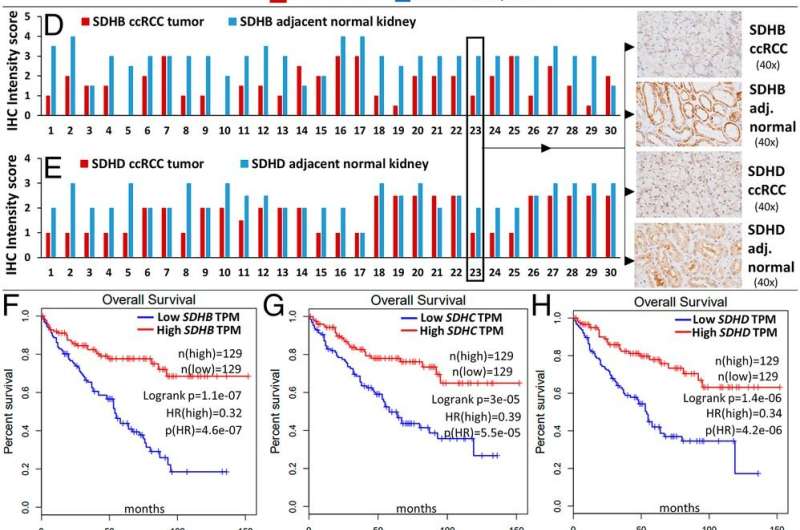Study identifies expanded role for metabolic enzyme in kidney cancer

A team of investigators has discovered that the underexpression of a specific metabolic enzyme is a common and adverse epigenetic modulating feature in clear cell renal cell carcinoma (ccRCC), according to a recent study published in Proceedings of the National Academy of Sciences.
The findings demonstrate that functional deficiency of the enzyme, succinate dehydrogenase (SDH), is a common feature of ccRCC, which accounts for 80 percent of all kidney cancers, and is not just limited to .05 to .5 percent of kidney cancers with SDH germline mutations, as currently classified by the World Health Organization (WHO).
"Previously, reduced SDH activity was considered pathogenically relevant only in 0.05 to 0.5 percent of kidney cancers associated with germline mutations in SDH subunit-encoding genes. What we are now showing is that reduced SDH activity is actually pathogenically relevant in a large majority of ccRCC, via underexpression of SDH subunits, and ccRCC accounts for around 80 percent of all kidney cancers," said Niraj Shenoy, MD, Ph.D., associate professor of Medicine in the Division of Hematology and Oncology and senior author of the study.
SDH is the only metabolic enzyme known to play a role in both the tricarboxylic acid (TCA) cycle and the electron transport chain, processes which are essential for cells to generate and release energy. Reduced SDH activity prevents the metabolic conversion of succinate to fumarate in the TCA cycle, and leads to the accumulation of succinate, which has oncogenic effects via epigenetic modulation, which is further highlighted in the current study.
The 2016 WHO classification of kidney tumors identifies "SDH-deficient renal carcinoma" as a separate entity, referring mainly to kidney cancers associated with germline mutations in any of the SDH subunits, which is 0.05 to 0.5 percent of kidney cancers.
To further determine the overall role of SDH loss in kidney cancer pathogenesis and progression, Shenoy and collaborators used several molecular biology techniques to study ccRCC tumor cell lines, primary tumor samples, as well as data from The Cancer Genome Atlas program through the National Cancer Institute.
The investigators found that SDH deficiency was prevalent in a large majority of patients with ccRCC, which accounts for roughly 80 percent of all kidney cancers, and contributed to adverse epigenetic effects. Furthermore, SDH deficiency was associated with worse overall and disease-free survival in these patients. The authors then went on to shed light on the molecular mechanisms leading to SDH downregulation in ccRCC and the adverse biologic consequences of this downregulation.
The findings have prompted the investigators to call on the WHO to rename the "SDH-deficient renal carcinoma" entity as "SDH germline mutation-associated renal carcinoma," both for nomenclature accuracy and to avoid confusion in recognizing a small group of kidney cancer patients who have distinct clinical and pathologic manifestations.
"While we believe our findings warrant a change in the nomenclature, the most significant part of the work is shedding light on the immense oncogenic relevance of, and molecular mechanisms involved in, SDH downregulation in ccRCC," said Shenoy, who is also a member of the Robert H. Lurie Comprehensive Cancer Center of Northwestern University.
More information: Ritesh K. Aggarwal et al, Functional succinate dehydrogenase deficiency is a common adverse feature of clear cell renal cancer, Proceedings of the National Academy of Sciences (2021). DOI: 10.1073/pnas.2106947118


















